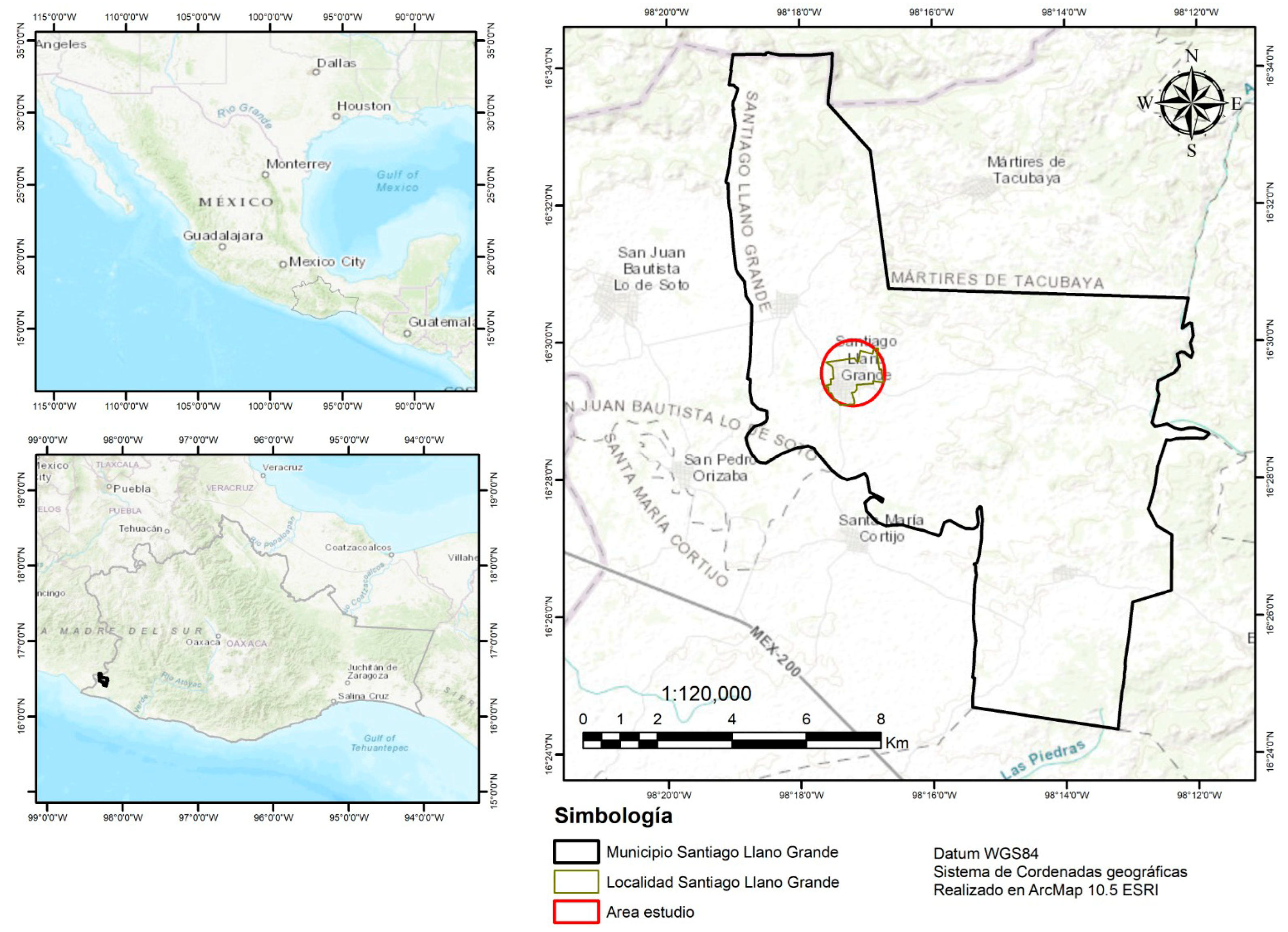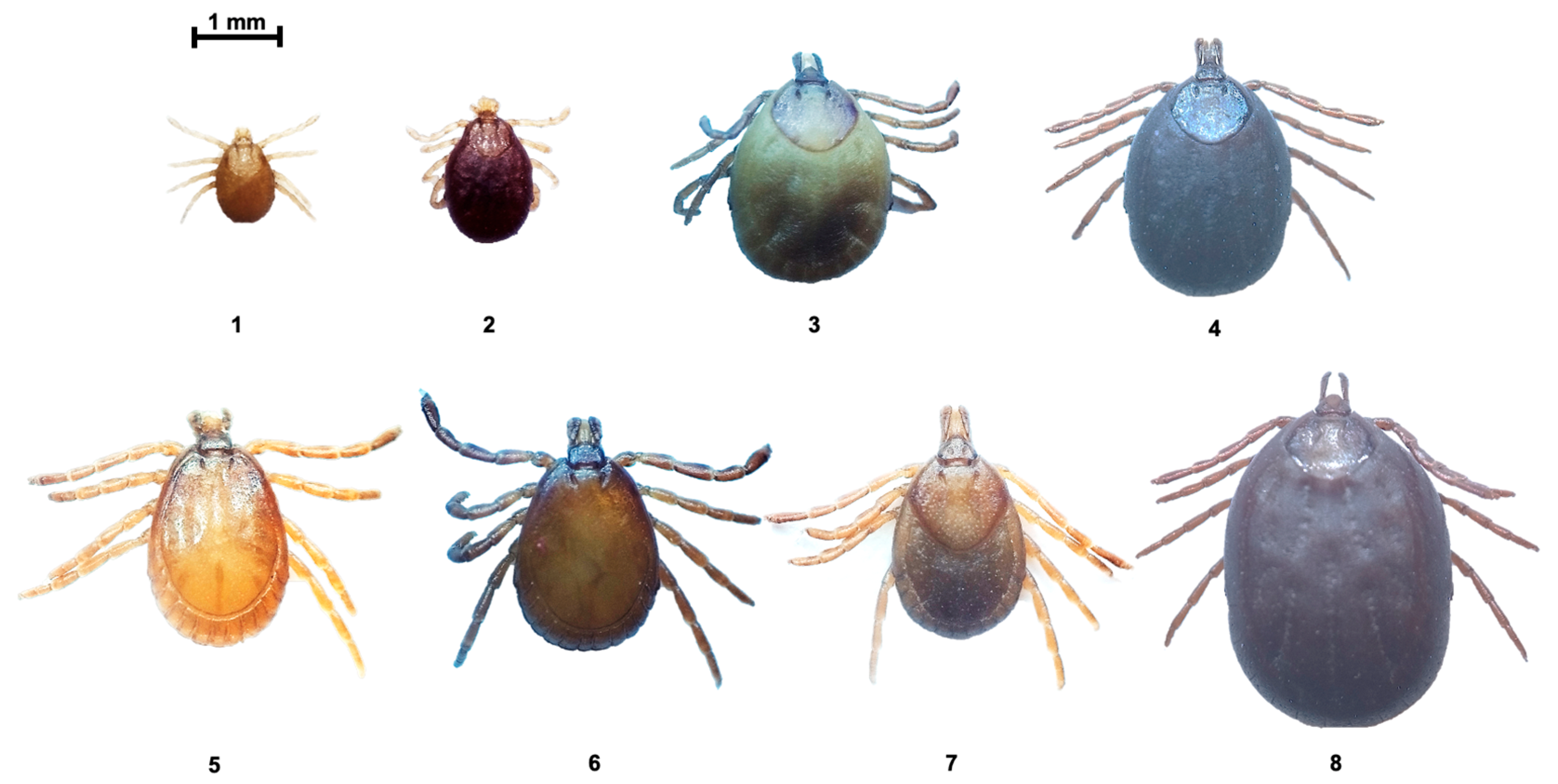Amblyomma auricularium (Acari: Ixodidae) in Nine-Banded Armadillo, Dasypus novemcinctus: A New Record for the Neotropical Region of Mexico
Abstract
1. Introduction
2. Materials and Methods
3. Results
4. Discussion
5. Conclusions
Author Contributions
Funding
Data Availability Statement
Conflicts of Interest
References
- Conil, P.A. Description d’une nouvelle espèce d’ixode, Ixodes auricularius. Acta Acad. Nac. Cienc. Exactas 1878, 3, 99–110. [Google Scholar]
- Guglielmone, A.A.; Nava, S.; Robbins, R.G. Geographic distribution of the hard ticks (Acari: Ixodida: Ixodidae) of the world by countries and territories. Zootaxa 2023, 5251, 1–274. [Google Scholar] [PubMed]
- Guzmán-Cornejo, C.; Herrera-Mares, A.; Paredes-León, R.; García-Prieto, L. Actualización de la riqueza de garrapatas de los géneros Ixodes y Amblyomma (Ixodida: Ixodidae) en México. Dugesiana 2023, 30, 163–176. [Google Scholar] [CrossRef]
- Guglielmone, A.A.; Robbins, R.G.; Apanaskevich, D.A.; Petney, T.N.; Estrada-Peña, A.; Horak, I.G. The Hard Ticks of the World (Acari: Ixodida: Ixodidae); Springer: New York, NY, USA, 2014; p. 738. [Google Scholar]
- Nava, S.; Venzal, J.M.; Acuña, D.G.; Martins, T.F.; Guglielmone, A.A. Ticks of the Southern Cone of America: Diagnosis, Distribution, and Hosts with Taxonomy, Ecology and Sanitary Importance; Academic Press: London, UK, 2017; p. 348. [Google Scholar]
- Sánchez-Soto, S.; Ramírez-Arenas, C.M.; Esteban-Guzmán, N.; Sánchez-Gómez, W.S. Registro notable de armadillo de cola desnuda, Cabassous centralis (Cingulata: Chlamyphoridae), en el estado de Chiapas, México. Mammal. Notes 2020, 6, 165. [Google Scholar] [CrossRef]
- Julián-Caballero, C.C. Nuevo registro del armadillo de nueve bandas Dasypus Novemcinctus (Cingulata: Dasypodidae) en el municipio de San Antonio Huitepec, Oaxaca, México. Mammal. Notes 2022, 8, 323. [Google Scholar] [CrossRef]
- McBee, K.; Baker, R.J. Dasypus novemcinctus. Mamm. Species 1982, 162, 1–9. [Google Scholar] [CrossRef]
- Whitaker, J.O., Jr.; Morales-Malacara, J.B. Ectoparasites and other associates (Ectodytes) of mammals of Mexico. In Contribuciones Mastozoológicas en Homenaje a Bernardo Villa Instituto de Biología e Instituto de Ecología, Universidad Nacional Autónoma de México; Sánchez-Cordero, V., Medellín, R.A., Eds.; Comisión Nacional para el Uso y Conocimiento de la Biodiversidad (CONABIO): Ciudad de México, México, 2005; pp. 535–666. [Google Scholar]
- SEMARNAT (Secretaría de Medio Ambiente y Recursos Naturales). 2010. Norma Oficial Mexicana NOM-O59-SEMARNAT-2010. Protección Ambiental—Especies Nativas de México de Flora y Fauna Silvestres-Categorías de Riesgo y Especificaciones para su Inclusión, Exclusión o Cambio—Lista de Especies en Riesgo. Ciudad de México: Diario Oficial de la Federación (Segunda Sección). Available online: https://www.dof.gob.mx/normasOficiales/4254/semarnat/semarnat.htm (accessed on 5 January 2025).
- Ávila-Nájera, D.M.; Rosas-Rosas, O.C.; Tarango-Arámbula, L.A.; Martínez-Montoya, J.F.; Santoyo-Brito, E. Conocimiento, uso y valor cultural de seis presas del jaguar (Panthera onca) y su relación con éste, en San Nicolás de los Montes, San Luis Potosí, Mexico. Rev. Mex. Biodivers. 2011, 82, 1020–1028. [Google Scholar] [CrossRef]
- Monroy-Vilchis, O.; Cabrera, L.; Suárez, P.; Zarco-González, M.M.; Rodríguez-Soto, C.; Urios, V. Uso tradicional de vertebrados silvestres en la Sierra Nanchititla, México. Interciencia 2008, 33, 308–313. [Google Scholar]
- López-de Buen, L.; Zárate-Ledesma, F.; Ahuja, C.; Vázquez-Morales, C.; Carrasco, A.; Montiel-Palacios, F. Uso antropogénico, hábitat, abundancia y hábitos alimentarios del armadillo de nueve bandas (Dasypus novemcinctus) en el centro y sur del estado de Veracruz, México. Edentata 2017, 18, 42–50. [Google Scholar] [CrossRef]
- Briceño-Mendez, M.A.; Puc-Kauil, R. Depredación de armadillo (Dasypus novemcinctus) por jaguar (Panthera onca) en México. Cienc. Lat. Rev. Científica Multidiscip. 2021, 5, 4693. [Google Scholar]
- dos Santos, A.R.; Paise, G. Diseases associated with nine-banded armadillo (Dasypus novemcinctus) Dasypodidae consumption: A literature review. In Proceedings of the Congresso Internacional de Conservação de Xenarthra, 1ª edição, Brasilia, Brazil, 30 November 2020. [Google Scholar]
- INEGI. Instituto Nacional de Estadística y Geografía. Compendio de Información Geográfica Municipal de los Estados Unidos Mexicanos Santiago Llano Grande, Oaxaca clave Geoestadística 20474. 2010. Available online: https://www.inegi.org.mx/contenidos/app/mexicocifras/datos_geograficos/20/20474.pdf (accessed on 22 May 2025).
- PMDD. Santiago Llano Grande, Jamiltepec, Oaxaca. Plan Municipal de Desarrollo Rural Sustentable 2008–2010. Eje Ambiental. 2010. Available online: https://www.finanzasoaxaca.gob.mx/pdf/inversion_publica/pmds/08_10/474.pdf (accessed on 22 May 2025).
- USDA. United States Department of Agriculture. Ticks of veterinary importance. In Agriculture Handbook No. 485; 1976. Available online: https://www.govinfo.gov/content/pkg/GOVPUB-A-PURL-gpo27523/pdf/GOVPUB-A-PURL-gpo27523.pdf (accessed on 1 February 2024).
- Guzmán-Cornejo, C.; Robbins, R.G.; Guglielmone, A.A.; Montiel-Parra, G.; Pérez, T.M. The Amblyomma (Acari: Ixodida: Ixodidae) of Mexico: Identification keys, distribution and hosts. Zootaxa 2011, 2998, 16–38. [Google Scholar]
- Martins, T.F.; Labruna, M.B.; Mangold, A.J.; Cafrune, M.M.; Guglielmone, A.A.; Nava, S. Taxonomic key to nymphs of the genus Amblyomma (Acari: Ixodidae) in Argentina, with description and redescription of the nymphal stage of four Amblyomma species. Ticks Tick-Borne Dis. 2014, 5, 753–770. [Google Scholar] [CrossRef] [PubMed]
- Voltzit, O.V. A review of neotropical Amblyomma species (Acari: Ixodidae). Acarina 2007, 15, 3–134. [Google Scholar]
- Bermúdez, S.; Apanaskevich, D.; Domínguez, L. Garrapatas Ixodidae de Panamá; Secretaría Nacional de Ciencia, Tecnología e Innovación: Panamá, Panamá, 2018; p. 129. [Google Scholar]
- Robinson, L.E. Ticks. A Monograph of the Ixodoidea. Part IV. The Genus Amblyomma; Cambridge University Press: London, UK, 1926; p. 302. [Google Scholar]
- Camicas, J.L.; Hervy, J.P.; Adam, F.; Morel, P.C. Les Tiques du Monde (Acarida, Ixodida): Nomenclature, Stades Décrits, Hôtes, Repartition; Orstom: Paris, France, 1998; p. 233. [Google Scholar]
- Keirans, J.E.; Hillyard, P.D. A catalogue of the type specimens of Ixodida (Acari: Argasidae, Ixodidae) deposited in The Natural History Museum, London. Occas. Pap. Syst. Entomol. 2001, 13, 1–74. [Google Scholar]
- Guglielmone, A.A.; Viñabal, A.E. Claves morfológicas dicotómicas e información ecológica para la identificación de garrapatas del género Amblyomma Koch, 1844 de la Argentina. Rev. Investig. Agropecu. 1994, 25, 39–67. [Google Scholar]
- Lahille, F. Contribution à l’étude des ixodidés de la République Argentine. An. Minist. Agric. República Argent. 1905, 2, 1–166. [Google Scholar]
- Boero, J.J. Las Garrapatas de la República Argentina (Acarina: Ixodoidea); Departamento Editorial de la Universidad de Buenos Aires: Buenos Aires, Argentina, 1957; p. 113. [Google Scholar]
- Barros-Battesti, D.M.; Arzua, M.; Bechara, G.H. Carrapatos de Importância Médico-Veterinária da Região Neotropical: Um Guia Ilustrado para Identificação de Espécies; Vox/ICTTD-3/Butantan: São Paulo, Brazil, 2006; p. 223. [Google Scholar]
- Venzal, J.M.; Castro, O.; Guglielmone, A.A.; Keirans, J.E. First records of Amblyomma auricularium (Conil, 1878) and Amblyomma pseudoconcolor Aragão, 1908 (Acari: Ixodidae) from Uruguay. Syst. Appl. Acarol. 2002, 7, 109–111. [Google Scholar] [CrossRef]
- Aragão, H.d.B.; Fonseca, F. Da. Notas de ixodología. V. A propósito da validade de algunas espécies do genero Amblyomma do continente Americano (Acari: Ixodidae). Mem. Inst. Oswaldo Cruz 1953, 51, 485–492. [Google Scholar] [CrossRef]
- Fairchild, G.B.; Kohls, G.M.; Tipton, V.J. The ticks of Panama (Acarina: Ixodoidea). In Ectoparasites of Panama; Field Museum of Natural History: Chicago, IL, USA, 1966; pp. 167–219. [Google Scholar]
- Aragão, H.B. Notas sobre Ixodidas brasileiros. Mem. Inst. Oswaldo Cruz 1911, 3, 145–195. [Google Scholar] [CrossRef]
- Guglielmone, A.A.; Mangold, A.J.; Keirans, J.E. Redescription of the male and female of Amblyomma parvum Aragao, 1908, and description of the nymph and larva, and description of all stages of Amblyomma pseudoparvum sp. n. (Acari: Ixodida: Ixodidae). Acarologia 1990, 31, 143–159. [Google Scholar]
- Guglielmone, A.A.; Petney, T.N.; Mastropaolo, M.; Robbins, R.G. Genera, subgenera, species and subspecies of hard ticks (Acari: Ixodidae) described, named, renamed or given new rank by Paul Schulze (1887–1949) and their current status. Zootaxa 2017, 4325, 1–66. [Google Scholar] [CrossRef]
- Hoffmann, A. Presencia en México de Amblyomma curruca Schulze 1936. An. Esc. Nac. Cien. Biol. 1950, 6, 78–80. [Google Scholar]
- Arana-Guardia, R.; Baak-Baak, C.M.; Cigarroa-Toledo, N.; Reyes-Solis, G.C.; Ojeda-Robertos, N.F.; García-Rejón, J.E.; Zarza, H.; Ceballos, G.; Machain-Williams, C. Ticks (Acari: Ixodidae) from wild mammals in fragmented environments in the south of Yucatan Peninsula, Mexico. Southwest Entomol. 2015, 40, 657–660. [Google Scholar] [CrossRef]
- Rodríguez-Vivas, R.I.; Apanaskevich, D.A.; Ojeda-Chi, M.M.; Trinidad-Martínez, I.; Reyes-Novelo, E.; Esteve-Gassent, M.D.; de León, A.P. Ticks collected from humans, domestic animals, and wildlife in Yucatan, Mexico. Vet. Parasitol. 2016, 215, 106–113. [Google Scholar] [CrossRef]
- Solís-Hernández, A.; Rodríguez-Vivas, R.I.; Esteve-Gasent, M.D.; Villegas-Pérez, S.L. Detección de Borrelia burgdorferi sensu lato en perros y sus garrapatas en comunidades rurales de Yucatán, México. Rev. Biol. Trop. 2018, 66, 428–437. [Google Scholar] [CrossRef][Green Version]
- Light, J.; Eckerlin, R.E.; Durden, L.A. Checklist of ectoparasites of Canidae and Felidae in Mexico. Therya 2019, 10, 109–119. [Google Scholar] [CrossRef]
- Saraiva, D.G.; Nieri-Bastos, F.A.; Horta, M.C.; Soares, H.S.; Nicola, P.A.; Pereira, L.C.; Labruna, M.B. Rickettsia amblyommii infecting Amblyomma auricularium ticks in Pernambuco, northeastern Brazil: Isolation, transovarial transmission, and transstadial perpetuation. Vector Borne Zoonotic Dis. 2013, 13, 615–618. [Google Scholar] [CrossRef]
- Cohen, E.B.; Auckland, L.D.; Marra, P.P.; Hamer, S.A. Avian migrants facilitate invasions of neotropical ticks and tick- borne pathogens into the United States. Appl. Environ. Microbiol. 2015, 81, 8366–8378. [Google Scholar] [CrossRef]
- Apperson, C.S.; Engber, B.; Nicholson, W.L.; Mead, D.G.; Engel, J.; Yabsley, M.J.; Dail, K.; Johnson, J.; Watson, D.W. Tick-borne diseases in North Carolina: Is “Rickettsia amblyommii” a possible cause of rickettsiosis reported as Rocky Mountain spotted fever? Vector Borne Zoonotic Dis. 2008, 8, 597–606. [Google Scholar] [CrossRef]
- Yen, W.Y.; Stern, K.; Mishra, S.; Helminiak, L.; Sanchez-Vicente, S.; Kim, H.K. Virulence potential of Rickettsia amblyommatis for spotted fever pathogenesis in mice. Pathog. Dis. 2021, 79, ftab024. [Google Scholar] [CrossRef]
- Walker, A.R.; Bouattour, A.; Camicas, J.L.; Estrada-Pena, A.; Horak, I.G.; Latif, A.A.; Pegram, R.G.; Preston, P.M. Ticks of Domestic Animals in Africa: A Guide to Identification of Species; Biosciences Reports: Edinburgh, UK, 2007; p. 21. [Google Scholar]
- Faccini, J.L.; Cardoso, A.C.; Onofrio, V.C.; Labruna, M.B.; Barros-Battesti, D.M. The life cycle of Amblyomma auricularium (Acari: Ixodidae) using rabbits (Oryctolagus cuniculus) as experimental host. Exp. Appl. Acarol. 2010, 50, 71–77. [Google Scholar] [CrossRef] [PubMed]



| Host | Total Ticks | Nymphs | Females | Males | ||||
|---|---|---|---|---|---|---|---|---|
| Uf | SE | E | Uf | SE | E | |||
| 1 | 5 | - | - | - | 1 | 2 | 1 | 1 |
| 2 | 6 | - | 1 | - | - | - | - | 5 |
| 3 | 7 | - | 1 | - | - | - | - | 6 |
| 4 | 14 | 3 | 2 | - | 1 | 2 | 1 | 5 |
| 5 | 15 | - | - | 1 | 6 | 2 | - | 6 |
| 1 | 5 | - | - | - | 1 | 2 | 1 | 1 |
| Total | 52 | 3 | 4 | 1 | 9 | 8 | 3 | 24 |
Disclaimer/Publisher’s Note: The statements, opinions and data contained in all publications are solely those of the individual author(s) and contributor(s) and not of MDPI and/or the editor(s). MDPI and/or the editor(s) disclaim responsibility for any injury to people or property resulting from any ideas, methods, instructions or products referred to in the content. |
© 2025 by the authors. Licensee MDPI, Basel, Switzerland. This article is an open access article distributed under the terms and conditions of the Creative Commons Attribution (CC BY) license (https://creativecommons.org/licenses/by/4.0/).
Share and Cite
González-Álvarez, V.H.; Prudente-Peláez, E.; Díaz-Vargas, L.Á.; Ayala-Monter, M.A.; Alvarado-Rodríguez, G.; Guzmán-Cornejo, C. Amblyomma auricularium (Acari: Ixodidae) in Nine-Banded Armadillo, Dasypus novemcinctus: A New Record for the Neotropical Region of Mexico. Arthropoda 2025, 3, 9. https://doi.org/10.3390/arthropoda3020009
González-Álvarez VH, Prudente-Peláez E, Díaz-Vargas LÁ, Ayala-Monter MA, Alvarado-Rodríguez G, Guzmán-Cornejo C. Amblyomma auricularium (Acari: Ixodidae) in Nine-Banded Armadillo, Dasypus novemcinctus: A New Record for the Neotropical Region of Mexico. Arthropoda. 2025; 3(2):9. https://doi.org/10.3390/arthropoda3020009
Chicago/Turabian StyleGonzález-Álvarez, Vicente Homero, Elena Prudente-Peláez, Luis Ángel Díaz-Vargas, Marco Antonio Ayala-Monter, Gabriela Alvarado-Rodríguez, and Carmen Guzmán-Cornejo. 2025. "Amblyomma auricularium (Acari: Ixodidae) in Nine-Banded Armadillo, Dasypus novemcinctus: A New Record for the Neotropical Region of Mexico" Arthropoda 3, no. 2: 9. https://doi.org/10.3390/arthropoda3020009
APA StyleGonzález-Álvarez, V. H., Prudente-Peláez, E., Díaz-Vargas, L. Á., Ayala-Monter, M. A., Alvarado-Rodríguez, G., & Guzmán-Cornejo, C. (2025). Amblyomma auricularium (Acari: Ixodidae) in Nine-Banded Armadillo, Dasypus novemcinctus: A New Record for the Neotropical Region of Mexico. Arthropoda, 3(2), 9. https://doi.org/10.3390/arthropoda3020009







